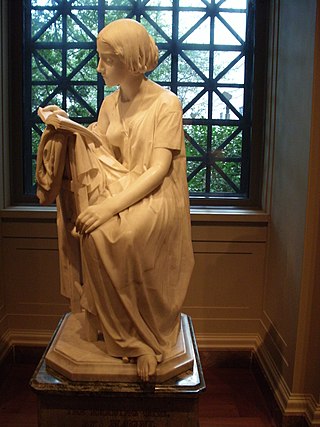
La Lettrice, also known as "Reading Girl", is a marble sculpture created by Pietro Magni in 1856, the original version is kept at the Galleria d'Arte Moderna (Milan),

La Lettrice, also known as "Reading Girl", is a marble sculpture created by Pietro Magni in 1856, the original version is kept at the Galleria d'Arte Moderna (Milan),
Unlike traditional sculptures, La Lettrice does not have an unexpressive goddess face, instead it has human facial expressions. The girl is sitting on a chair with no shoes, reading a book written by poet and playwright Giovanni Battista Niccolini. On the original sculpture, lines from the text can be read: one of them is celebrating the freedom of Lombardy from Austrian Empire persecution after the Revolutions of 1848 with an emotive expression with a tear on her cheek. La Lettrice represent Italy as a young nation coming into maturity. [1]

After the creation of the original sculpture, other versions were created and can be seen in other places, another version of La Lettrice can be seen at the National Gallery of Art.

Villa Borghese is a landscape garden in Rome, containing a number of buildings, museums and attractions. It is the third-largest public park in Rome, after the ones of the Villa Doria Pamphili and Villa Ada. The gardens were developed for the Villa Borghese Pinciana, built by the architect Flaminio Ponzio, developing sketches by Scipione Borghese, who used it as a villa suburbana, or party villa, at the edge of Rome, and to house his art collection. The gardens as they are now were remade in the late 19th century.

Giovanni Battista Salvi da Sassoferrato, also known as Giovanni Battista Salvi, was an Italian Baroque painter, known for his archaizing commitment to Raphael's style. He is often referred to only by the town of his birthplace (Sassoferrato), as was customary in his time, and for example seen with da Vinci and Caravaggio.

The Galleria Nazionale d'Arte Antica or National Gallery of Ancient Art is an art museum in Rome, Italy. It is the principal national collection of older paintings in Rome – mostly from before 1800; it does not hold any antiquities. It has two sites: the Palazzo Barberini and the Palazzo Corsini.
Museums of modern art listed alphabetically by country.

The Galleria Nazionale d'Arte Moderna e Contemporanea, also known as La Galleria Nazionale, is an art museum in Rome. It was founded in 1883 on the initiative of the then minister Guido Baccelli and is dedicated to modern and contemporary art.

Romano Romanelli was an Italian artist, writer, and naval officer, known for his sculptures and his medals.

Giovanni Battista Biscarra or Jean-Baptiste Biscarra was an Italian painter, sculptor and lithographer. He principally painted historical and religious subjects and royal portraits.

Giuseppe Pellizza da Volpedo was an Italian Divisionist painter. Pellizza was a pupil of Pio Sanquirico. He used a Divisionist technique in which a painting is created by juxtaposing small dots of paint according to a specific colour theory. Although he exhibited often, his work achieved popularity in death through their reproduction in socialist magazines and the acclaim they received from 20th-century art critics.

Ludovico De Luigi is a contemporary Italian sculptor and painter born and living in Venice, Italy.

Pietro Magni was an Italian sculptor. Born in Milan, he studied at that city's Accademia di Belle Arti di Brera before moving to the workshop of Abbondio Sangiorgio. Later in his career he became influenced by Tuscan sculptor Lorenzo Bartolini, whose work he first encountered in 1837. He traveled to study in Rome, joining Giuseppe Garibaldi in 1849. He is best known for his Girl Reading, first carved in 1856; today the original may be seen in Galleria d'Arte Moderna, Milan, while copies exist in numerous other museum collections, e.g. in Palácio Nacional da Ajuda, Lisbon. Among Magni's other works are a public monument to Leonardo da Vinci on Piazza della Scala and several marble sculpture groups; he also executed statues for the Milan Cathedral in the 1860s.

Ettore Tito was an Italian artist particularly known for his paintings of contemporary life and landscapes in Venice and the surrounding region. He trained at the Accademia di Belle Arti in Venice and from 1894 to 1927 was the Professor of Painting there. Tito exhibited widely and was awarded the Grand Prize in painting at the 1915 Panama–Pacific International Exposition in San Francisco. In 1926 he was made a member of the Royal Academy of Italy. Tito was born in Castellammare di Stabia in the province of Naples and died in Venice, the city which was his home for most of his life.
Giulio Paolini is an Italian artist associated with both Arte Povera and Conceptual Art.

Francesco Messina was an Italian sculptor of the 20th century.

The Galleria d'Arte Moderna is a modern art museum in Milan, in Lombardy in northern Italy. It is housed in the Villa Reale, at Via Palestro 16, opposite the Giardini Pubblici Indro Montanelli. The collection consists largely of Italian and European works from the eighteenth to the twentieth centuries.

Ida Botti Scifoni was an Italian painter, sculptor and designer. She was married to Felice Scifoni, and was a teacher and friend of Mathilde Bonaparte, Napoleon’s niece.

Giovanni Battista Niccolini was an Italian poet and playwright of the Italian unification movement or Risorgimento.

Yumi Karasumaru is a Japanese artist. She lives and works in Bologna, Italy, and Kawanishi, Japan.

Pietà is a c. 1600 oil on canvas painting by Annibale Carracci, the earliest surviving work by him on the subject, which was commissioned by Odoardo Farnese. It moved from Rome to Parma to Naples as part of the Farnese collection and is now in the National Museum of Capodimonte in Naples. It is one of many 16th century Bolognese paintings dedicated to the theme of the Pietà, and it is counted among Carracci's masterpieces.